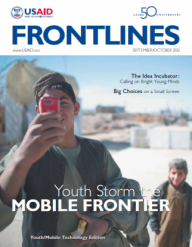From my vantage point of working in information and communications technology (ICT) for development for over 15 years—first at the World Bank, then at the Peace Corps and now at USAID—I’ve been excited that mobile technologies designed to help us bridge the “last mile” to homes, schools and communities in developing countries are closer than ever to doing just that.
Today’s mobile phone has a processor that is 10 times as fast as the processor on Curiosity, the Mars rover, and has 16 times as much storage. This power, combined with greater accessibility and falling costs is providing enormous possibilities for helping shape the work we do in international development.
In 1996, I was hired just out of graduate school by the World Bank to work as a distance education specialist. One of my early assignments was serving as the Anglophone Africa regional manager of a program named World Links for Development (WorLD). Working with ministries of education, schools and community stakeholders, WorLD established computer and Internet-related centers in secondary schools in a number of countries around the world. WorLD accelerated the use of ICTs by teachers and students to improve teaching and learning. It also promoted international collaborative projects between students in Africa, Asia and Latin America and those in developed countries, such as the United States and the U.K. Unfortunately, the costs and lack of access to available technologies were still substantial and hampered project expansion around the world.
While at the World Bank, I observed the dizzying pace of technological awareness and adoption, even in poor-resource communities. Just as we in higher-resource settings appreciate and seek out various “media” platforms (e.g., print, audio, video) and technologies (e.g., radio, television, Internet), there should be no doubt that citizens, students, teachers and parents in the countries where we work in international development also want the same opportunities for economic empowerment, educational development, knowledge sharing and communication.
I fondly remember in 1999 following a briefing about a school-based telecenter (a computer and Internet center open for school and community access) we hoped to develop outside Bulawayo, Zimbabwe, when a wizened elder asked me if the computers were going to be Y2K compliant. They were!
When I was with the Peace Corps, I again was struck by the seemingly exponential growth of mobile coverage to rural communities, which we tracked from one year to the next in annual reports. In their FY 2011 All Volunteer Survey, 94 percent of respondents reported having daily access to mobile calls, and over three-fourths had at least weekly access to the Internet.
Today, according to the International Telecommunications Union, the U.N. agency tasked with monitoring global ICT trends, 95 percent of the world is now reachable through mobile phone coverage.
The international development community has entered into a brave new world of exploring technology use to advance our development objectives to all corners of the earth. This is particularly exciting for the education sector where combinations of mobile technologies can include a multitude of handheld devices. Audio and video players, e-readers, flash drives, micro-projectors and, obviously, mobile phones can help track education data, promote literacy, advance youth and livelihood development, and allow content to flow to low-resource settings.
In my current role at USAID, I have been fortunate that one of the activities I have been given the space and resources to catalyze is the Mobiles for Education Alliance, or mEducation. In close coordination with staff at JBS International Inc., we interviewed over 80 key individuals from international development organizations, NGOs, the private sector and research organizations to ascertain whether or not there was need for such a body. We found that there was enormous excitement for the formation of such a group, particularly to channel our collective energies and professional expertise for improving the quality of education in developing countries.
Launched in 2011, the initiative has an ambitious, but doable, goal: to improve access to low-cost, appropriate and sustainable mobile technologies that can help boost quality learning in formal school settings as well as non-traditional locations in developing countries. It’s thrilling—and humbling—to think about how much intellectual and technical expertise we can combine and unleash in this arena.
Our current mEducation topic explorations include using mobile technologies for reading, for youth and workforce development, for delivering educational programming in complex and challenging environments, and for general system strengthening. For example, we are starting to see more examples of mobile phones, tablets and other devices being used to improve reading assessment to enhance instruction for individual learners. E-Readers—which can be charged at mobile phone power supply kiosks—are being used in countries such as Ghana, Nigeria, Kenya and the Philippines to provide reading materials in low-resource settings. Mobile phones are helping young people find job opportunities in the West Bank and Gaza.
Many of the initiatives we are tracking are at the pilot stage. One of the key ambitions of the mEducation Alliance is to attract a network of organizations and funding to rigorously evaluate promising practices so those deemed successful can be nationally scaled and used as leverage for lowering technological costs.
As with other mobile development initiatives, the mEducation Alliance aims to avoid duplication of efforts, highlight good practices and catalyze innovations within the field to add value to our global education efforts. We’re approaching this with a sense of cautious optimism and humility: Technology-supported interventions can complement and strengthen existing education efforts, but cannot replace informed education leadership, quality instruction and substantial investments in teacher professional development.
The alliance has a steering committee comprised of key representatives from across U.S. Government agencies, multinational donors, NGOs, and public- and private-sector associations. This is a loose confederation of organizations and very much in its early stages, but over the last two years we’ve co-hosted research roundtables and Web-based seminars, and held our second annual mEducation Alliance Symposium in early September 2012 with over 200 participants exploring better ways to maximize partnership and the impact of mobile technology use for education.
The wealth of talent, expertise and motivation from participants at these forums and reached through other platforms is truly awe-inspiring. As we move the mEducation Alliance forward, we anticipate many challenges—and opportunities—including building a trustworthy and timely “platform” for candidly sharing what works and what doesn’t in this field and developing a true multi-stakeholder initiative which energizes, leverages and returns value to and from many stakeholders. If we can tap into and shape just a sliver of this intellectual “power stream,” we will be in great shape to help move the field forward.










Comment
Make a general inquiry or suggest an improvement.